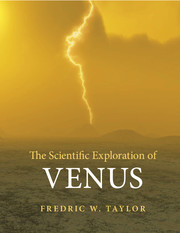Book contents
- Frontmatter
- Contents
- Overview
- Prologue
- A note on scientific units
- Acknowledgements
- Part I Views of Venus, from the beginning to the present day
- Part II The motivation to continue the quest
- Chapter 9 Origin and evolution
- Chapter 10 Atmosphere and ocean
- Chapter 11 A volcanic world
- Chapter 12 The mysterious clouds
- Chapter 13 Superwinds and polar vortices
- Chapter 14 The climate on Venus, past, present and future
- Chapter 15 Could there be life on Venus?
- Part III Plans and visions for the future
- Epilogue
- References and acknowledgements
- Appendix A Chronology of space missions to Venus
- Appendix B Data about Venus
- Index
- Plate section
Chapter 9 - Origin and evolution
the solid planet
from Part II - The motivation to continue the quest
Published online by Cambridge University Press: 05 September 2014
- Frontmatter
- Contents
- Overview
- Prologue
- A note on scientific units
- Acknowledgements
- Part I Views of Venus, from the beginning to the present day
- Part II The motivation to continue the quest
- Chapter 9 Origin and evolution
- Chapter 10 Atmosphere and ocean
- Chapter 11 A volcanic world
- Chapter 12 The mysterious clouds
- Chapter 13 Superwinds and polar vortices
- Chapter 14 The climate on Venus, past, present and future
- Chapter 15 Could there be life on Venus?
- Part III Plans and visions for the future
- Epilogue
- References and acknowledgements
- Appendix A Chronology of space missions to Venus
- Appendix B Data about Venus
- Index
- Plate section
Summary
Twin planets?
When considering the solid planets and not their climate at the surface (which is the subject of Chapter 10), Earth and Venus seem very similar and really are twin planets. But they are not identical twins. We have already seen that Venus is 5 per cent smaller in diameter and quite different in its orbital dynamics, with slow retrograde rotation and near-zero obliquity. The absence of a magnetic field is one of the few really clear indications that we have that the deep interiors are not altogether the same. The absence, or at least the difference in character, of plate tectonics on Venus suggests major differences in the solid crust, as do substantial differences in the geography of the two surfaces.
It is a crucial part of our outlook on the world, and not just as scientists, to try to understand to what extent Venus and Earth are the same and to what extent they differ, and why. To a very great degree, we still lack the experimental evidence to answer this, although some progress has been made. When considering the solid body, progress will continue to be slow because it is much harder to make surface and, especially, interior measurements of the kind we need. This is in contrast to the atmosphere, which is now quite well studied because it is relatively accessible. Unless there is a surprising increase in the amount of effort and money devoted to planetary exploration and prospecting, it will be a long time until we have data from deep-drilled cores and seismological measurements on Venus that are comparable to those that are responsible for so much of our knowledge about the earth below our feet.
- Type
- Chapter
- Information
- The Scientific Exploration of Venus , pp. 119 - 140Publisher: Cambridge University PressPrint publication year: 2014



